What are the various types of Sewerage systems?
Sewerage is the infrastructure that transports sewage and surface runoff through a sewer system. Receiving drains, manholes, pumping stations, stored overflows, and screening chambers of the combined sewer or sanitary sewer are all included.
Sewage enters the system at the point of discharge into the environment or at the entrance of sewage treatment plant. It is the network of pipes, chambers, manholes, and other structures that transport sewage and stormwater.
Types of Sewerage Systems
- Combined System
- Separate System
- Partially Separate System
1: Combined Sewerage System
Combined sewers are systems that transport a mixture of household sewage and storm sewage. Because of the huge volumes of storm water that must be handled during wet weather periods, combined sewers are often made out of large-diameter pipes or tunnels. They're ubiquitous in older cities, but they're no longer constructed or built as part of modern sewer systems. Because wastewater treatment plants are unable to manage high amounts of storm water, sewage must be discharged straight into the receiving water during wet weather. These combined sewer overflows, which contain untreated home sewage, produce recurrent water pollution issues and are extremely difficult pollution sources.
Situations for adoption
A: The amount of rain falls evenly throughout the year.
B: Pumping of both sanitary sewage and stormwater is required.
C: The area to be severed is densely populated, and there is insufficient space to place pipes.
D: More efficient or faster flows must be given.
E: A combined system is desirable if the sewers are installed in conjunction with the overall development of the area.
2: Separate System
New wastewater treatment plants are constructed as separate systems, handling either domestic or storm sewage but not both. Surface runoff is normally carried to a location of disposal in a stream or river by storm sewers. Small detention basins could be installed as part of the system to temporarily store storm water and reduce peak flow rates. On the other hand, sanitary sewers transport domestic wastewater to a sewage treatment plant. Industrial wastewater that has been pre-treated may be allowed into municipal sanitary sewage systems, while storm water is not.
Situations for adoption
A: When there is a lot of rain but it isn't evenly distributed.
B: There will be one outlet for sanitary sewage, and other outlets for store or surface water will be available.
C: Pumping of sanitary sewage is required.
D: To save money on excavation, the separate sewer should be deeper and the stormwater drains should be closer to the surface.
E: If the site has steep slopes, it is easier to convert stormwater to a natural stream using an open drain.
F: Financial resources are limited, yet sanitary drainage is critical.
G: It is more difficult and expensive to build a large combined sewer if the subsoil is hard.
H: It is best to have a separate system if sewers are installed before the area is developed.
3: Partially Separate System
A partially separate system is a variant of the separate system in which the separate sewer that discharges residential sewage and industrial wastes also contains a portion of the surface water drained from the house's back-paved yards and rooftops.
Why we need partially separate systems?
For the following reasons, a combined sewerage system has not been determined to be quite adequate under tropical Indian conditions:
A: Heavy and concentrated rainfall during the monsoon season, which lasts only 3 to 4 months in most places. As a result, there is a significant variance in the amount of sewage flow throughout the year.
B: Inadequate amounts of waste water reaching the sewers due to a large area of unsewered land or other factors, resulting in the dry weather flow (DWF) being a small percentage of the total flow.
C: The poor state of the economy and the little funds available.
D: Difficulties with system operation and maintenance owing to insufficient supervision of less skilled personnel. Local government agencies in charge of the task frequently do not place a high priority on retaining trained and skilled personnel.
For the reasons stated above, it has been determined that in practise, a compromise between the separate and integrated systems is required, with the partially combined or partially separate system being used as much as practicable.
Conclusion
If you need any information about types of wastewater or sewage treatment plants best suited for you, get in touch with Netsol water solutions. An expert from our technical sales team can provide any additional information you require.
Netsol water is one of the leading water and wastewater treatment company in India with services in the field of WTP plant manufacturing, WWTP plant manufacturing, sewage treatment plant manufacturing and much more. The company designs and manufactures all in one systems that are ideal for treating wastewater and the sludge generated at a sewage treatment plant.
Netsol Water is Greater Noida-based leading water & wastewater treatment plant manufacturer. We are industry's most demanding company based on client review and work quality. We are known as best commercial RO plant manufacturers, industrial RO plant manufacturer, sewage treatment plant manufacturer, Water Softener Plant Manufacturers and effluent treatment plant manufacturers. Apart from this 24x7 customer support is our USP. Call on +91-9650608473, or write us at enquiry@netsolwater.com for any support, inquiry or product-purchase related query.



